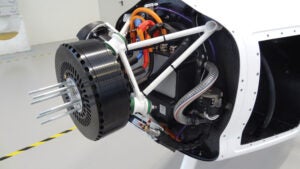Interest in building electrically powered aircraft is strong, but as yet the reality is no electric motor package is ready to plug and play except Slovenian airframer Pipistrel’s. Even then, integrating the Pipistrel package into an airframe is up to the builder unless you’re repowering a Rotax 503-powered Taurus, which is what the Pipistrel package is built around.
Past Pipistrel, adventurous amateur builders are pretty much on their own to source a motor, batteries and controller and integrate it into an airframe. One big help in such a quest is to repurpose the electric innards of a Zero Motorcycle, which we address in the nearby “Circling The Airport” sidebar.
Pipistrel

Pipistrel offers a standard 40 kW motor with a 60 kW option. A full suite of supporting equipment such as batteries, battery charger, controller, propellers, instruments, control levers and the like are offered à la carte to produce a custom electric propulsion package. Pipistrel also has the trapeze and controls for a retractable arm should you be designing a motorglider.
Converting a Zero Motorcycle to aviation duty involves considerable cost—an entire motorcycle is sacrificed in the process—and serious amounts of self-guided fabrication compared to modern kit aircraft practice. But it’s the craftsman’s path to basic electric flight.
| Manufacturer/Model | Drive Type | Horsepower | Weight | Price |
|---|---|---|---|---|
| Pipistrel Aircraft | ||||
| 20 Ah 4.75 kWh Electric Propulsion System | direct | 40 kW takeoff, 30 kW climb | 130 lb w/ batteries, motor and controls | $16,100 est.* |
| 20 Ah 4.75 kWh Electric Propulsion System | direct | 60 kW takeoff, 50 kW continuous, upgraded | 130 lb w/ batteries, motor and controls | $19,000 est.* |















Thanks, Tom. I fly an eGull, Earthstar Aircraft’s electric Ultralight. I started with a 5.4 kWh battery pack in 2013 but found I could stay airborne for only about 35 minutes (no reserve). I replaced the entire power train 4 years ago including a 13.5 kWh battery (yes, I had to buy another Zero Motorcycle wreck) and have been flying 250 missions since, most between 30 and 45 minutes. This setup is working great – absolutely no issues, no maintenance (even the PSRU belt is as tight as on day one), and you cannot beat the operating cost (about $1.20 per flight). I like to turn off the motor once at altitude to enjoy silent flight, knowing that the motor will come on immediately when I need it. On approach, I can use regenerative braking to adjust the slope and put a little juice back into the battery. And of course, I like that I don’t spew lead and CO2 into the atmosphere.
It’s great to hear you’re getting some fun flying in for so little cost per flight, Martin. The silent flight time sounds especially inviting, too.
Now, if your electricity was coming from a solar array, that would be about as carbon-free as you can get.